When it comes to piano manufacturing worldwide, American piano brands have surely made their mark.
Although all American pianos may not carry the same glamour or luxurious sheen that European or Japanese piano brands do, we still have a deep appreciation for them.
We think they all have distinct qualities, even if they aren’t the ultra high-end instruments made by Steinway or Mason & Hamlin. Moreover, these pianos represent a different era in our country’s culture and industry, carrying with them a rich heritage and unique charm.
So in honor of the recent 4th of July holiday, let’s celebrate the legacy of American piano manufacturing and dive into some of its history.
The history here is unsurprisingly pretty nuanced. We’ve kept it somewhat simple though — and linked to other sources for any further reading. Enjoy!
Early History of American Piano Manufacturing
If you wanted a piano in the United States prior to the 1800s, you were likely importing a piano from Europe — and they weren’t quite like the ones we know today!
This square grand piano was made in 1815 by a Scottish piano manufacturer Wood, Bruce & Co. Square pianos were the most popular type of piano in the mid-1800s. They were initially imported from Europe to the US, and eventually made by American manufacturers like Steinway & Sons!
1775: First American Made Piano
The very first American made piano was built by John Berent in 1775 — also the year the American Revolution started.
He immigrated from London to open his shop in Philadelphia.
Based on the piano’s construction, it’s assumed that Berent worked closely with Americus Backers, another piano maker in London who employed similar techniques.
We know it wasn’t imported from Backers though since the piano uses tulip poplar, a wood native to the United States (that frankly is too cheap to bother exporting).
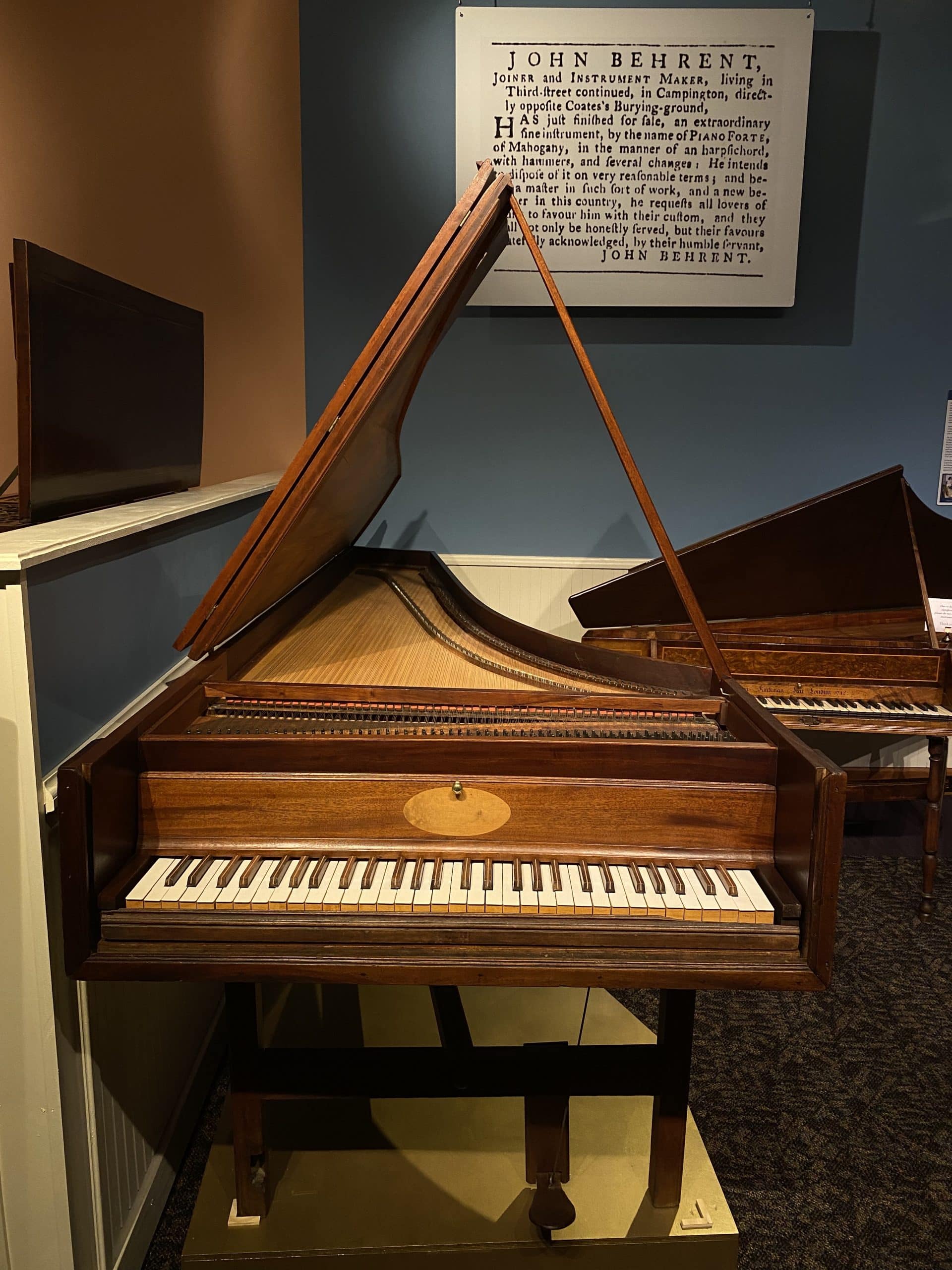
Source: Sigal Music Museum
1800: First Upright Piano Built
It was then in the year 1800 when John Isaac Hawkins built the first upright piano in Philadelphia.
Originally, the keyboard on these upright pianos actually flipped out.
It was also called a “Hawkins Portable Grand Piano” before the upright and vertical names stuck.
While this was no doubt a landmark moment for piano manufacturing, it’s funny to see mention of how poorly these early upright pianos seemingly played. Apparently even the 3rd president of the United States had some words. . . .
. . . [Thomas] Jefferson’s interest prompted him to purchase one of Hawkins’s instruments (5.5 octaves), for which he paid $264. Jefferson undoubtedly regretted the expenditure. The Hawkins piano could not be kept in tune, and after two years Jefferson returned it for repairs–at an additional cost of $40.
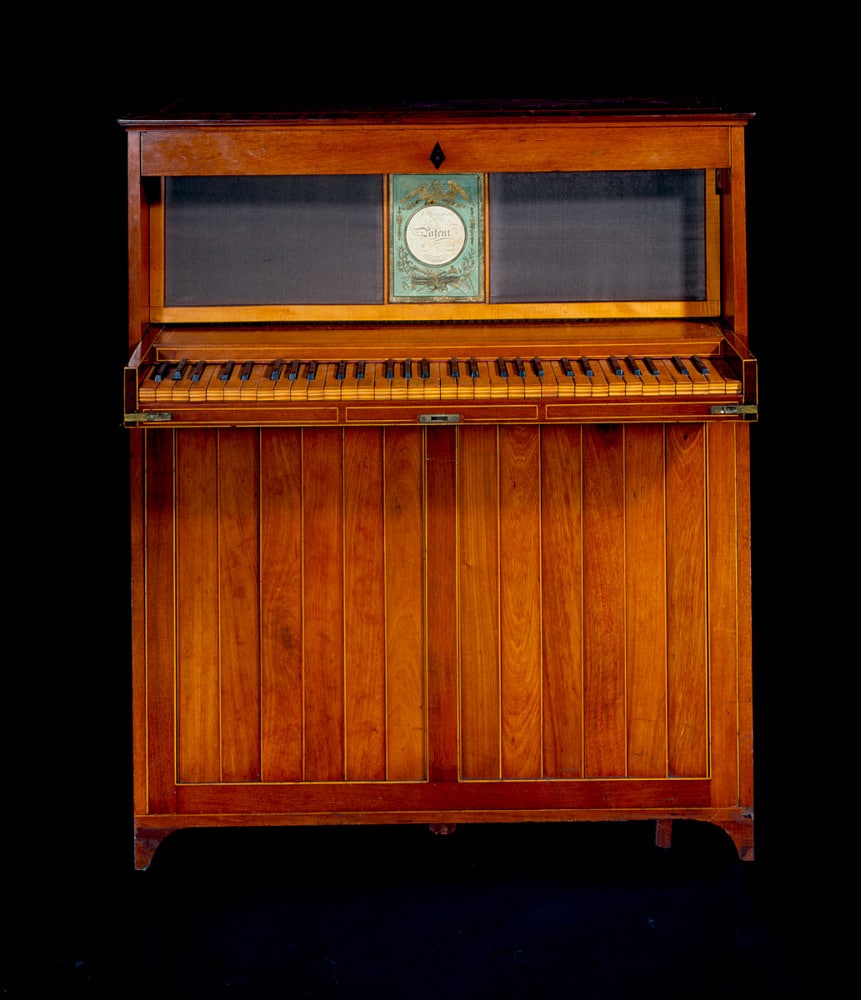
Source: Smithsonian Museum
1825: Invention of the Cast-Iron Plate
Hawkins was one of the first people to see the importance of using iron in pianos, an idea that influenced other early manufacturers like Alpheus Babcock and Jonas Chickering (who founded another notable and early piano company, Chickering & Sons, in 1823).
Babcock’s invention of the cast-iron frame in 1825 then proved the idea revolutionary, and it’s easily one of the most important developments in piano manufacturing at large.
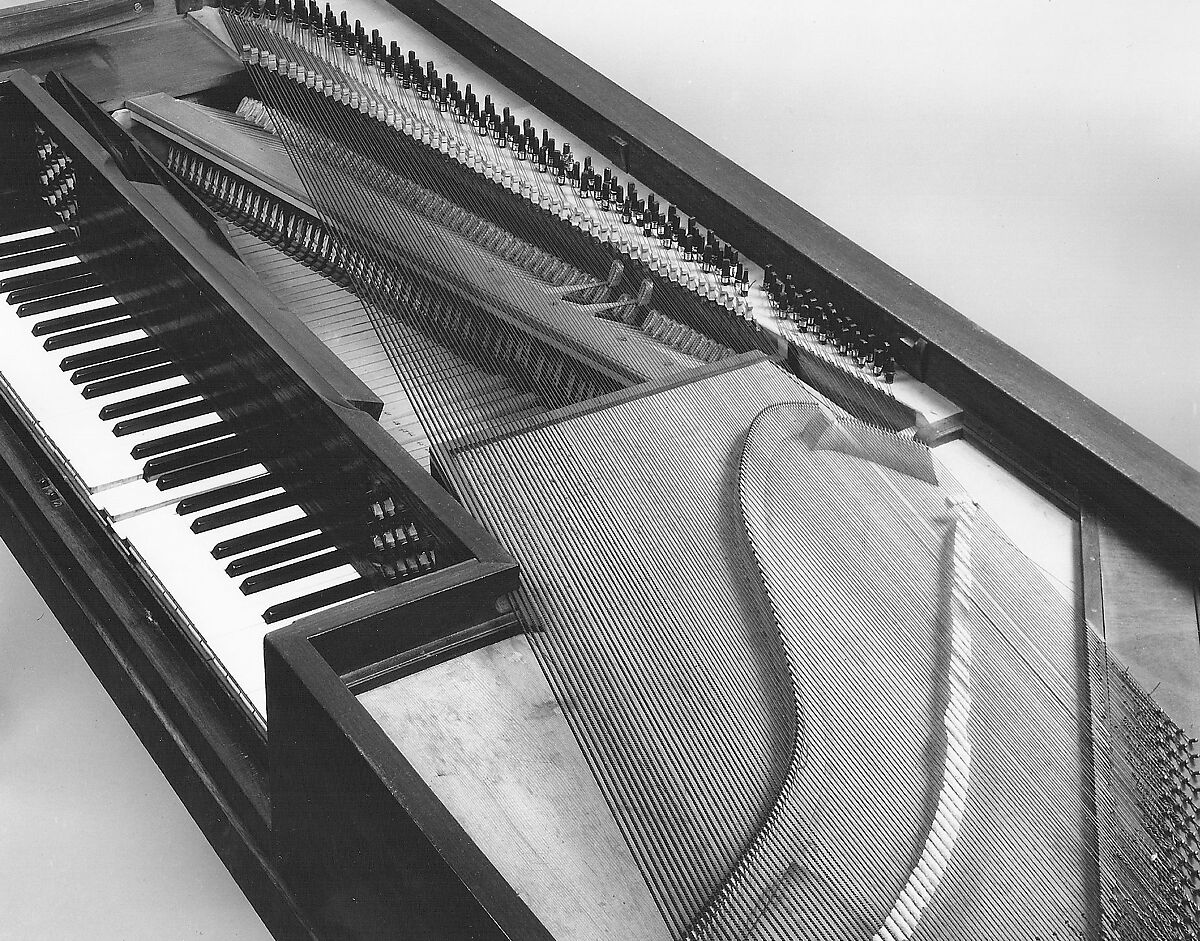
Square piano made by Alpheus Babcock, for which he patented the very first cast iron frame. Source: The MET
For a long time now, no piano has been made without a cast-iron plate. It allows for greater tension on the strings and ultimately, a more powerful sound.
Mid-1800s: American Piano Industry Booms
Advancements in woodworking and metalworking, as well as assembly line techniques, then allowed American manufacturers to produce better pianos more efficiently and at lower costs.
As a result, American piano manufacturing began to boom starting in the mid-1800s.
Several prominent American piano brands were founded during this time, including Steinway & Sons in 1853, Mason & Hamlin in 1854 and Baldwin in 1857.
Early-1900s: Golden Era of American Pianos
Through the early 1900s, the 100s of American piano companies in existence began to experiment with different types of materials and manufacturing techniques in an effort to improve overall quality.
We also saw significant developments to player pianos around this time. Read our article on the History of the Self Playing Piano!
In 1923, there were nearly 350,000 pianos sold nationwide — the peak of piano sales in the United States.
Many considered pianos to be the centerpiece of the home throughout the early 1920s, and owning one was seen as a sign of status and culture. In fact, 1 in every ~99 homes had a piano around this time (compared to 1 in every ~4,000 today).
Factors in the Fall of American Piano Brands
By 1929, the total number of pianos sold in the US fell to 131,000. This was the year that many American piano companies began to notice their time in the sun was coming to an end.
Even giants at the time ultimately went out of business. There were a number of factors that caused this, none of which really preventable.
1929: The Great Depression
The earliest catalyst was the Great Depression. In and of itself, this had a huge impact on American piano manufacturing.
Several dozens of piano companies went out of business throughout the decade. Others still were acquired by the two huge American Piano Company; and Aeolian, Weber Piano & Pianola Company conglomerates.
Even above this, the middle class was squeezed and people’s priorities began to shift. Demand for pianos thus decreased, and of course related industries like the number of music teachers took a hit as well.
1920s: New Mediums for Music Arise
Music culture was also beginning to shift, and new mediums started becoming more convenient. Do realize that the piano was the first popular way for families to enjoy music at home!
By the 1920s, phonographs had become popular household items though, with record companies producing millions of records each year. The first commercial radio station, KDKA in Pittsburgh, began broadcasting in 1920, and by the end of the decade, there were over 600 radio stations across the country too.
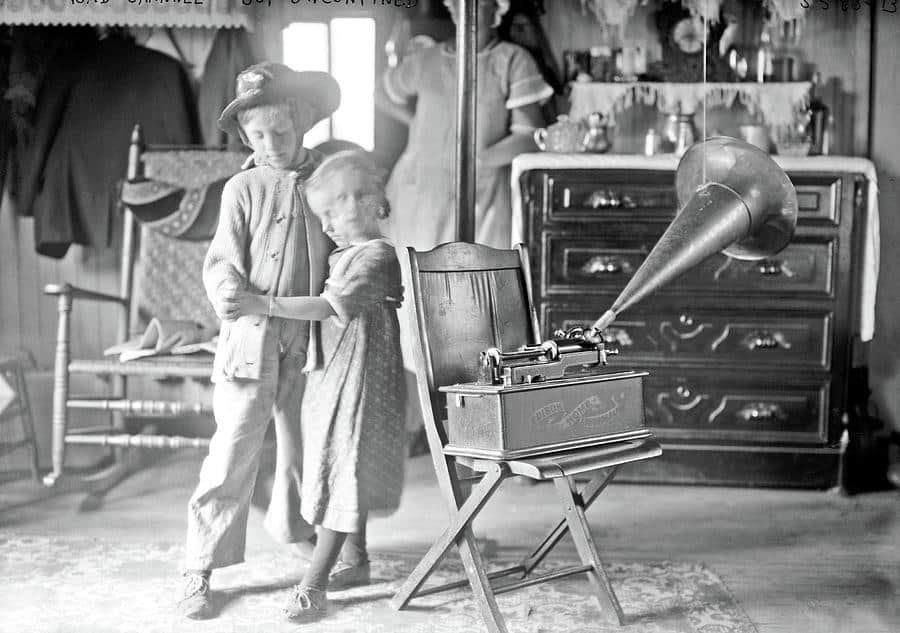
Boy and girl dancing while an Edison Home phonograph plays in a home in Broad Channel, Queens, New York City, 1910-15.
As music continued to become more accessible and mainstream, the country also began to enjoy different genres and form a more national identity. Thus, the piano began to lose its place as a central instrument in many styles of music — and as a centerpiece to homes.
1930s – 1980s: Electronic Keyboards Arrive
You may be surprised to learn that the first electronic instrument was developed in 1896. But the world wasn’t then ready for Thaddeus Cahill’s Telharmonium, an early electric organ.
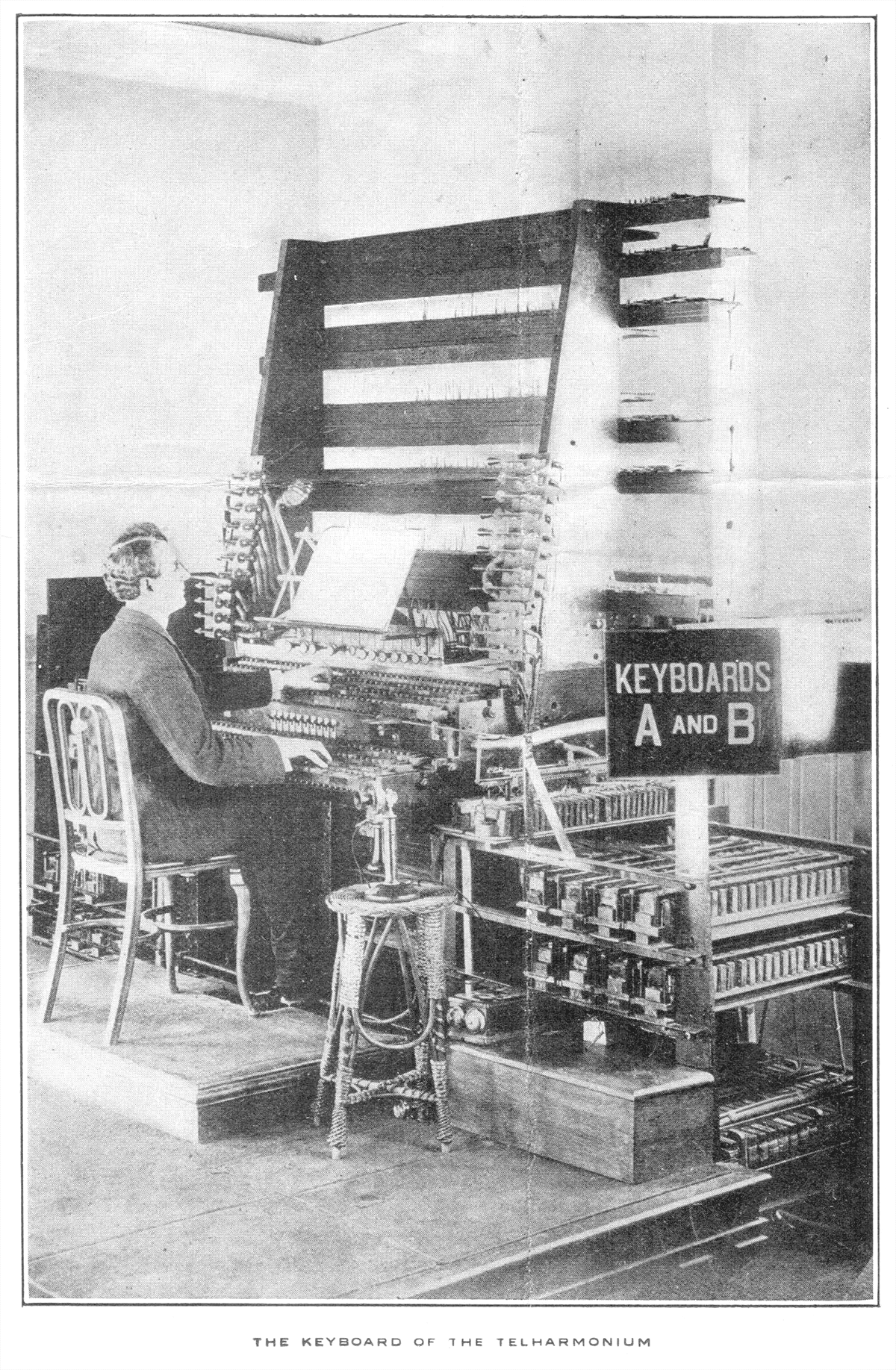
It was also pretty complicated as you can see. Very impressive piece of technology for 1895 -- and certainly a milestone for electronic music and instruments!
It wasn’t until the 1930s that electronic instruments gained any popularity, with the Hammond organ.
From then through the 1960s, electronic instruments became more and more advanced, paving the way for the popularity of synths and keyboards in the 1970s and 1980s.
Finally in 1984, the Yamaha Clavinova became the world’s first digital piano. This was the first time a digital piano used sampling technology to reproduce the sound of an acoustic piano and featured a weighted keyboard to simulate its feel.
While we typically use “digital piano” broadly, there is some distinction to be made historically about electric and electronic pianos. The first electric piano was the Neo-Bechstein in 1939, a grand that you could play to the built-in radio or record player.
Digital pianos even today cannot perfectly replicate the sound and feel of an acoustic piano, but they have become pretty good since 1984. As a result, they’ve become suitable alternatives to acoustic pianos — and much more popular than them for home use.
1960s – 1970s: Foreign Competition Rises
Apart from the economic downturn, shifts in culture and new trends in music, the final reason American piano companies never fully recovered is foreign competition.
Simply put, brands from Europe and Asia were able to produce high-quality pianos at a lower cost. This put significant pressure on American manufacturers to lower their prices, which often resulted in a reduction in quality.
One of the earliest instances of a foreign piano company making it big in the U.S. was the Japanese company Yamaha. Yamaha entered the American market in the 1960s, and by the 1970s, it had become one of the top-selling piano brands in the country. To this day it continues to dominate a pretty big market share worldwide.
So this basically cemented the fate of American piano manufacturing. Only higher-end production exists in the country today from just three companies: Steinway & Sons, Mason & Hamlin and Charles Walter.
For further reading, check out this extensive three-part Insider’s History of Mason & Hamlin.
Are American Pianos Good?
If you’re talking about American pianos made today, the answer is a resounding yes: American pianos are good.
Steinway and Mason & Hamlin can be considered the Ferraris and Lamborghinis of the piano industry. These iconic manufacturers have consistently delivered exceptional instruments that are revered by musicians and collectors worldwide.
Looking back at the past, the answer remains largely positive, although there were some exceptions. Following the Great Depression, we witnessed the emergence of spinet pianos and other cheaper alternatives flooding the market.
It is important to note though that there were still notable American-made pianos during this time that maintained their excellence. And provided they have been well cared for, these older instruments can still to this day be good pianos worth owning and playing.
Overall, it is a shame that pianos fell from prominence how they did in the US. Mostly, we think it’s the case that music became a more passive activity. While we point to the radio and digital pianos being factors in its downfall, it could’ve been true that new music led to new inspiration and more accessible pianos led to more pianists.
Well, here’s one piano store with a team of people that remain committed to preserving the piano’s legacy. We believe in a future where the beauty and joy of piano playing is reignited — and even hopeful for a new Golden Era to one day arrive.


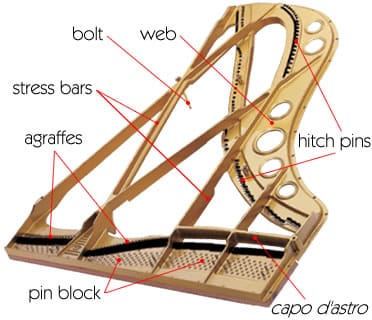
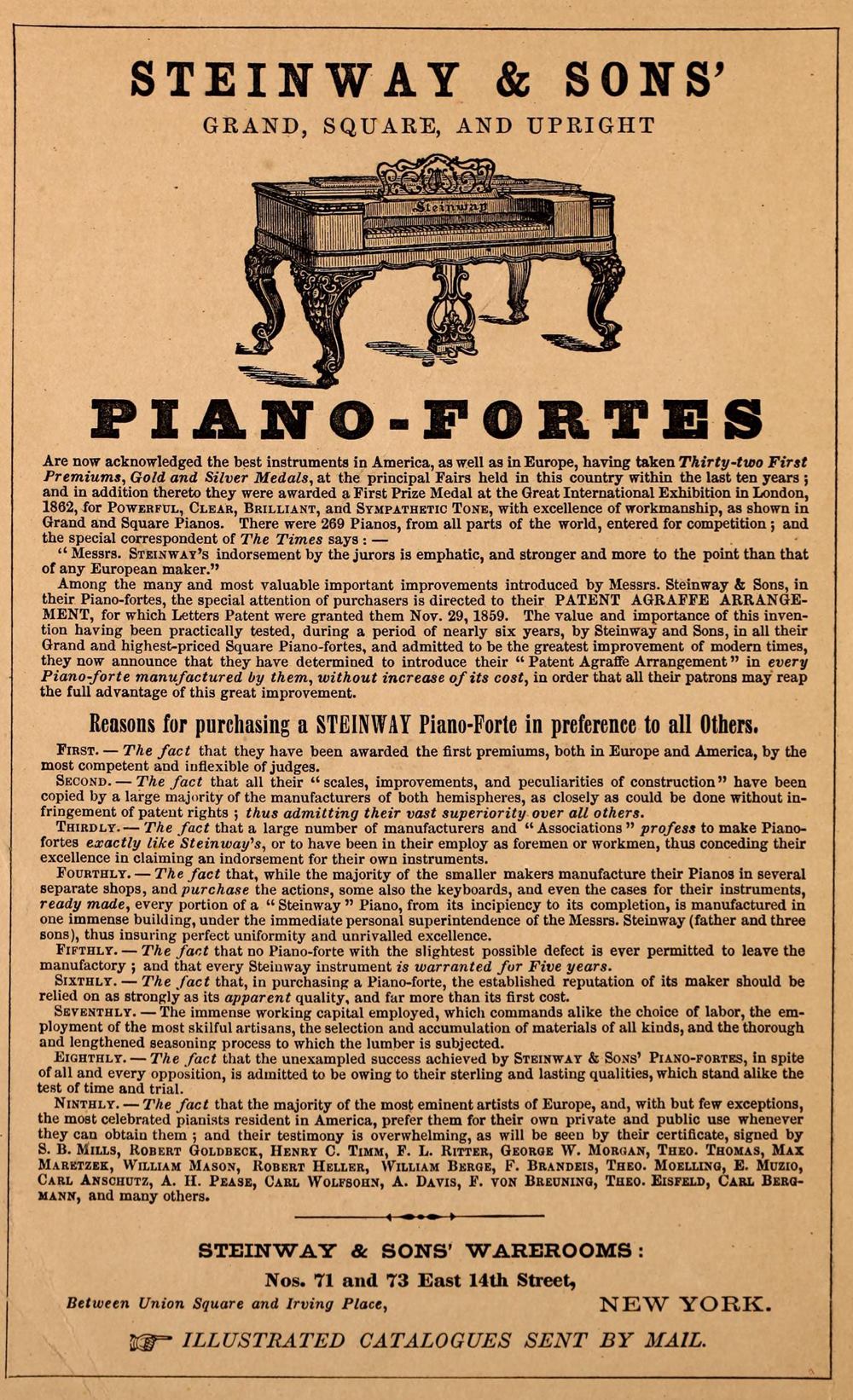



Hi, do you know anything about the Weberfield Piano Company in Philadelphia and New York. We have an Upright Orchestral Grand and would like to know how old it is.
Hi, Deborah! I’m afraid not. There’s Weber from New York, but I’ve never heard of Weberfield myself. There were many piano manufacturers that left without much trace; Weberfield may be one of them. In any case, if you’d like to email me some pictures, I could try to investigate a little or give you an approximate age! Certainly sounds like you may have a genuine antique! (:
Anyone know or heard of J. Walch & Son? And did they manufacturer pianos?
Hey, Sean! Looks like they did: https://www.utas.edu.au/library/companion_to_tasmanian_history/W/Walch.htm
There were a ton of piano manufacturers that went out of business around the turn of the 20th century. This might be one of them that didn’t leave much of a paper trail behind.
Looks like they are referenced as having been founded in 1869 based on this newspaper article from 1916.
We’ve never had one come in ourselves. They’d have to be proper antiques at this point.